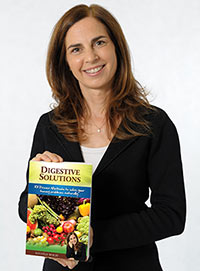
As seen on
By Michèle Wolff B.H.Sc Naturopathy, Dip. Colonics and Author of ‘Digestive Solutions’
Juicing has become a real trend amongst many health conscious consumers, but what are the real benefits and is there a difference between juicing and blending?
What many do not know is that a juicer breaks down the fruit or vegetable very differently to a blender. Juicing extracts certain ingredients such as pulp so it is smooth and easy to drink. Blending will provide a broken down version of the ingredients without ridding the juice of any vitamins and minerals, making it thicker and more nutritious.
Juicing
Drinking freshly-juiced fruit and vegetables gives the body live enzymes and bioactive vitamins and minerals, although some of the benefits from the skin of the fruit or vegetables, such as fibre, are removed. Many people are acidic and need alkalising, and vegetable juice and lemon in juice is fantastic for this. Raw juices have been used as a healing agent for many years. However, juicing extracts high amounts of vitamin C.
What are the benefits?
- The nutrients are easily absorbed.
- They are beneficial when the digestion is compromised and in the colder months ginger can be added for warmth and circulation. A little warm water can also be added.
- They have high antioxidants which are protective against cellular damage to the gut and the rest of the body.
- They are easy to prepare.
- Green juices are high in chlorophyll which is good for your red blood cells.
- Red, purple and blue juices (like cherries, blueberries and raspberries) actively decrease inflammation in the gut and other tissues in your body.
Blending
When blending, the key nutritional attributes of the fruit and vegetables largely remain. However, during the process of blending, oxygen makes its way into the fruit and vegetables creating the process of oxidisation. This slowly reduces the nutritional value of the fruit and vegetables, so it is important to blend for as short a time as possible.
What are the benefits?
- They are easy to prepare.
- The nutrients are easily absorbed.
- Fruit and vegetables are kept whole so the nutritional value is higher.
- Breaks down fruit and vegetables making them easily digestible in our bodies.
- You can easily add various fruit and vegetables that you normally wouldn’t eat on a daily basis.
- Fibre content of the fruit and vegetables will remain.
Both juicing and blending have beneficial elements for the body. However, blending ensures the whole fruit and vegetable is consumed. This keeps as much nutritional value as possible, similar to if you were eating the fruit and vegetable whole. Eating fruit and vegetables provides your body with the highest amount of nutritional value, but if you struggle to get your daily 2 and 5, both juicing and blending are quick and smart ways to boost your nutrition.
Michèle Wolff is a leading health practitioner and a qualified naturopath, nutritionist, herbalist and nurse. Her new book ‘Digestive Solutions – 101 Proven Methods to Solve Your Tummy Problems Naturally’ is available from bookstores and good online booksellers.
Visit www.digestivesolutions.com.au RRP $39.95





